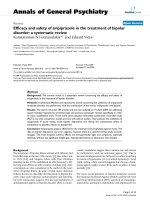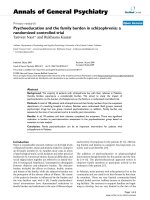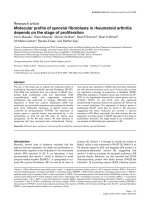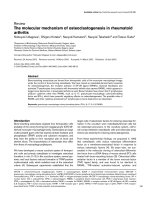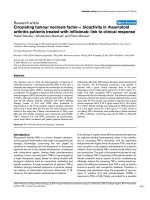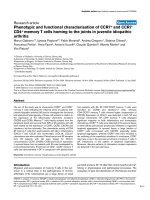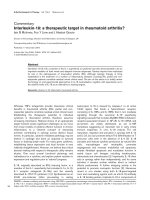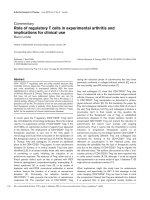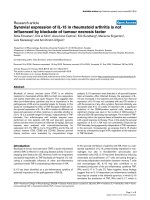Báo cáo y học: "γ Activating and inhibitory Fcγ receptors in rheumatoid arthritis: from treatment to targeted therapies" potx
Bạn đang xem bản rút gọn của tài liệu. Xem và tải ngay bản đầy đủ của tài liệu tại đây (38.87 KB, 2 trang )
Page 1 of 2
(page number not for citation purposes)
Available online />Abstract
Fcγ receptors (FcγRs) bind the constant Fc region of IgG
molecules. IgG/antigen-containing immune complexes elicit a
variety of effector functions in cells that express activating FcγRs.
Because activating FcγRs are present on cells from the innate
immune system, such as dendritic cells, monocytes/macrophages
and granulocytes, these IgG receptors form a crucial link between
the innate and the acquired immune systems. Recently, the ability
to detect the inhibitory FcγRIIb on cells has indicated an imbalance
between activating and inhibitory FcγRs in rheumatoid arthritis.
This progress offers an opportunity to study modulation of FcγR
balance and could stimulate development of FcγR-directed
immunotherapy.
Activating Fcγ receptors (FcγRs; FcγRI, FcγRIIa, FcγRIIIa and
FcγRIIIb) carry activation signalling motifs intracellularly,
which upon binding of IgG/antigen-containing immune
complexes can induce phagocytosis, antigen presentation,
antibody-dependent cell mediated cytotoxicity, and
complement-mediated lysis and cytokine secretion.
Expression of FcγRIIb, which carries an inhibitory signalling
motif, downregulates effector functions upon binding of IgG-
containing immune complexes, thereby preventing
proinflammatory responses mediated by activating FcγRs.
Studies of surface expression of the inhibitory FcγRIIb in
humans have for some time been hampered by the lack of
availability of antibodies that can distinguish between FcγRIIb
and FcγRIIa expression, because the extracellular part of
these receptors is highly homologous.
In the previous issue of Arthritis Research and Therapy,
Magnusson and coworkers [1] demonstrated increased
expression of both the inhibitory FcγRIIb and activating FcγRs
(FcγRI and FcγRIII) in synovial tissue of patients with
rheumatoid arthritis (RA) compared with that from healthy
control individuals. In addition, anti-inflammatory treatment
with glucocorticoids was shown to reduce expression of
activating FcγRs. Based on these data the authors conclude
that because RA patients do not fail to upregulate inhibitory
FcγRIIb receptors are upregulated in RA, targeting activating
FcγRs may represent a valuable therapeutic strategy.
Although FcγRIIb expression in RA synovial tissue is
demonstrated in this study, the actual levels were not
quantified and so it remains to be demonstrated whether the
balance at the site of inflammation is skewed compared with
the peripheral compartment. Recently, in the circulation of RA
patients compared with healthy control individuals, a skewed
balance toward activating receptors was demonstrated on
monocytes [2]. Recent findings indicate that regulation of this
FcγR balance markedly influences immunopathology in
arthritic conditions.
The balance of activating and inhibitory receptors is of major
importance to the elicited effector functions of cells upon
engagement of IgG or IgG-containing immune complexes. In
vitro, increased or sustained levels of activating over inhibitory
FcγR expression on monocytes (for example, by interferon-γ)
are associated with enhanced IgG-triggered proinflammatory
cytokine production. In contrast, regulation of the FcγR
balance in favour of inhibitory FcγRIIb expression (for
instance, by IL-4 and IL-4 plus IL-10) is associated with
prevention of IgG-triggered immune activation [2]. In
accordance with this, in mice it has been shown that
deficiency of activating FcγRs leads to inhibition of arthritis
and immunopathology, whereas deficiency of the inhibitory
FcγRIIb promotes arthritis and leads to increased
immunopathology [3]. Supporting human in vitro findings,
treatments that alter the balance between inhibitory and
activating FcγRs influence experimental arthritis [4]. Although
experimental data have shown the importance of shifting the
FcγR balance toward the inhibitory FcγRIIb, the effects of
Editorial
Activating and inhibitory Fc
γγ
receptors in rheumatoid arthritis:
from treatment to targeted therapies
Joel AG van Roon
Rheumatology & Clinical Immunology, University Medical Center Utrecht, Heidelberglaan, 3584 CX, Utrecht, The Netherlands
Corresponding author: Joel AG van Roon,
Published: 20 August 2007 Arthritis Research & Therapy 2007, 9:106 (doi:10.1186/ar2224)
This article is online at />© 2007 BioMed Central Ltd
See related research article by Magnusson et al., />FcγR = Fcγ receptor; IL = interleukin; RA = rheumatoid arthritis.
Page 2 of 2
(page number not for citation purposes)
Arthritis Research & Therapy Vol 9 No 4 van Roon
antirheumatic therapies in RA patients on FcγR balance,
either peripherally or locally, have not been studied. Thus far,
studies have only shown therapies to modulate activating
FcγRs; downregulation of activating FcγRs has been
demonstrated for glucocorticosteroids (FcγRI), methotrexate
(FcγRI and FcγRIIa) and anti-tumour necrosis factor-α (FcγRI),
and upregulation for IL-10 (FcγRI and FcγRIIa). Future studies
should document how the balance is altered by antirheumatic
drugs and how a shift toward the inhibitory FcγRIIb can be
optimized to improve treatment of arthritis. Considering the
arthritis-inducing capacity of antibodies characteristic for RA
[5], the new opportunity to study surface expression of
inhibitory and activating FcγRs will lead to enhanced
understanding of FcγR-mediated immunopathology in RA.
Apart from nonspecific modulation of the FcγR balance by
existing or currently developed treatments, specific targeting
of FcγRs offers a valuable therapeutic window of opportunity.
Ways to silence gene expression of activating FcγRs or
increase expression of FcγRIIb, for instance by using viral
expression vectors, may represent approaches to regulate
effector functions of FcγR-expressing cells. Illustrating the
potential of specific FcγR targeting, it was recently shown
that specific blockade of FcγRIIa inhibits IgG-triggered
proinflammatory cytokine production by dendritic cells
(tumour necrosis factor-α, IL-6 and IL-8) [6]. In contrast,
specific blockade of FcγRIIb enhanced this IgG-triggered
cytokine production.
FcγRs, by promoting delivery of antigen via IgG-containing
immune complexes to antigen-presenting cells such as
macrophages and dendritic cells, potently promote T-cell
activation in RA [7]. This function could contribute to the co-
localization of and strong correlation between numbers of
activating FcγR-expressing cells and T cells in RA synovial
tissue [1]. By enhancing the capacity of effector T cells to
activate B cells as well as fibroblasts and osteoclasts (and
macrophages and dendritic cells), FcγRs thus efficiently
augment inflammation and joint destruction in arthritic
conditions. In inflamed RA synovial tissue, macrophages and
dendritic cells have now been shown to express FcγRIIb in
addition to activating FcγRs [1,8]. Considering the pivotal role
played by these macrophages and dendritic cells in RA, and
the influence of FcγR balance on these cells in RA, it is
evident that more specific FcγR-directed therapies are
required to suppress RA optimally. Even blocking reagents
such as soluble FcγRs may lack sufficient therapeutic efficacy
because they will prevent IgG-containing immune complexes
from binding to activating but also inhibitory FcγRs. Drugs
that shift the FcγR balance toward the inhibitory FcγRIIb, such
as Fc-sialylated IgGs, which are present in intravenous
immune globulin preparations, are likely to have greater
therapeutic potential [4]. Enrichment for Fc-sialylated IgGs in
intravenous immune globulin preparations (from 1% to 2%, to
20%) resulted in a 10-fold increased capacity to suppress
experimental arthritis. Based on these findings, receptors for
sialic acid are postulated as candidate receptors that could
be exploited to induce FcγRIIb upregulation and suppress
inflammation. Finally, specific blockade of FcγRIIa or other
activating FcγRs or reagents that induce FcγRIIb-mediated
inhibition [9,10] could be used to optimize treatment of RA as
well as other rheumatic diseases.
Competing interests
The author declares that they have no competing interests.
References
1. Magnusson SE, Engstrom M, Jacob U, Ulfgren AK, Kleinau S:
High synovial expression of the inhibitory Fc
γγ
RIIb in rheuma-
toid arthritis. Arthritis Res Ther 2007, 9:R51.
2. Wijngaarden S, van de Winkel JG, Jacobs KM, Bijlsma JW,
Lafeber FP, van Roon JA: A shift in the balance of inhibitory and
activating Fcgamma receptors on monocytes toward the
inhibitory Fcgamma receptor IIb is associated with prevention
of monocyte activation in rheumatoid arthritis. Arthritis Rheum
2004, 50:3878-3887.
3. Kagari T, Tanaka D, Doi H, Shimozato T: Essential role of Fc
gamma receptors in anti-type II collagen antibody-induced
arthritis. J Immunol 2003, 170:4318-4324.
4. Kaneko Y, Nimmerjahn F, Ravetch JV: Anti-inflammatory activity
of immunoglobulin G resulting from Fc sialylation. Science
2006, 313:670-673.
5. Petkova SB, Konstantinov KN, Sproule TJ, Lyons BL, Awwami
MA, Roopenian DC: Human antibodies induce arthritis in mice
deficient in the low-affinity inhibitory IgG receptor Fc gamma
RIIB. J Exp Med 2006, 203:275-280.
6. Boruchov AM, Heller G, Veri MC, Bonvini E, Ravetch JV, Young
JW: Activating and inhibitory IgG Fc receptors on human DCs
mediate opposing functions. J Clin Invest 2005, 115:2914-
2923.
7. Sallusto F, Lanzavecchia A: Efficient presentation of soluble
antigen by cultured human dendritic cells is maintained by
granulocyte/macrophage colony-stimulating factor plus inter-
leukin 4 and downregulated by tumor necrosis factor alpha. J
Exp Med 1994, 179:1109-1118.
8. Radstake TR, Franke B, Wenink MH, Nabbe KC, Coenen MJ,
Welsing P, Bonvini E, Koenig S, van den Berg WB, Barrera P, et
al.: The functional variant of the inhibitory Fcgamma receptor
IIb (CD32B) is associated with the rate of radiologic joint
damage and dendritic cell function in rheumatoid arthritis.
Arthritis Rheum 2006, 54:3828-3837.
9. van Royen-Kerkhof A, Sanders EA, Walraven V, Voorhorst-Ogink
M, Saeland E, Teeling JL, Gerritsen A, van Dijk MA, Kuis W,
Rijkers GT, et al.: A novel human CD32 mAb blocks experi-
mental immune haemolytic anaemia in FcgammaRIIA trans-
genic mice. Br J Haematol 2005, 130:130-137.
10. Monari C, Kozel TR, Paganelli F, Pericolini E, Perito S, Bistoni F,
Casadevall A, Vecchiarelli A: Microbial immune suppression
mediated by direct engagement of inhibitory Fc receptor. J
Immunol 2006, 177:6842-6851.

